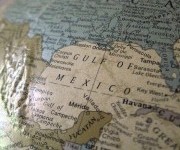Photo: elycefelizCross-posted from Cool Green Science.
Like sequels to a bad zombie movie, the dead zone in the Gulf of Mexico keeps coming back every summer. This time — according to a new NOAA report — it covers 6,765 square miles, exceeding the size of Connecticut.
But what is the “dead zone,” exactly? Why should we care? What can we do about it, and are proposed budget cuts in federally funded conservation programs going to make doing something about it even harder? (You can probably guess the answer to that last question.)
What it is: When excessive nutrients in the Mississippi River reach the Gulf, they cause an algae bloom that then dies and decomposes. Microbes eat the decomposing algae, depleting oxygen to fatal levels for fish and crustaceans, who then have to high-tail it further out into the Gulf where they can breathe easier (or, if that fails, asphyxiate). Scientists refer to this condition as “hypoxia,” but the term “dead zone” accurately and intuitively describes the situation, which usually is at its biggest and baddest in the summer. Similar dead zones occur in dozens of places around the worl... Read more

